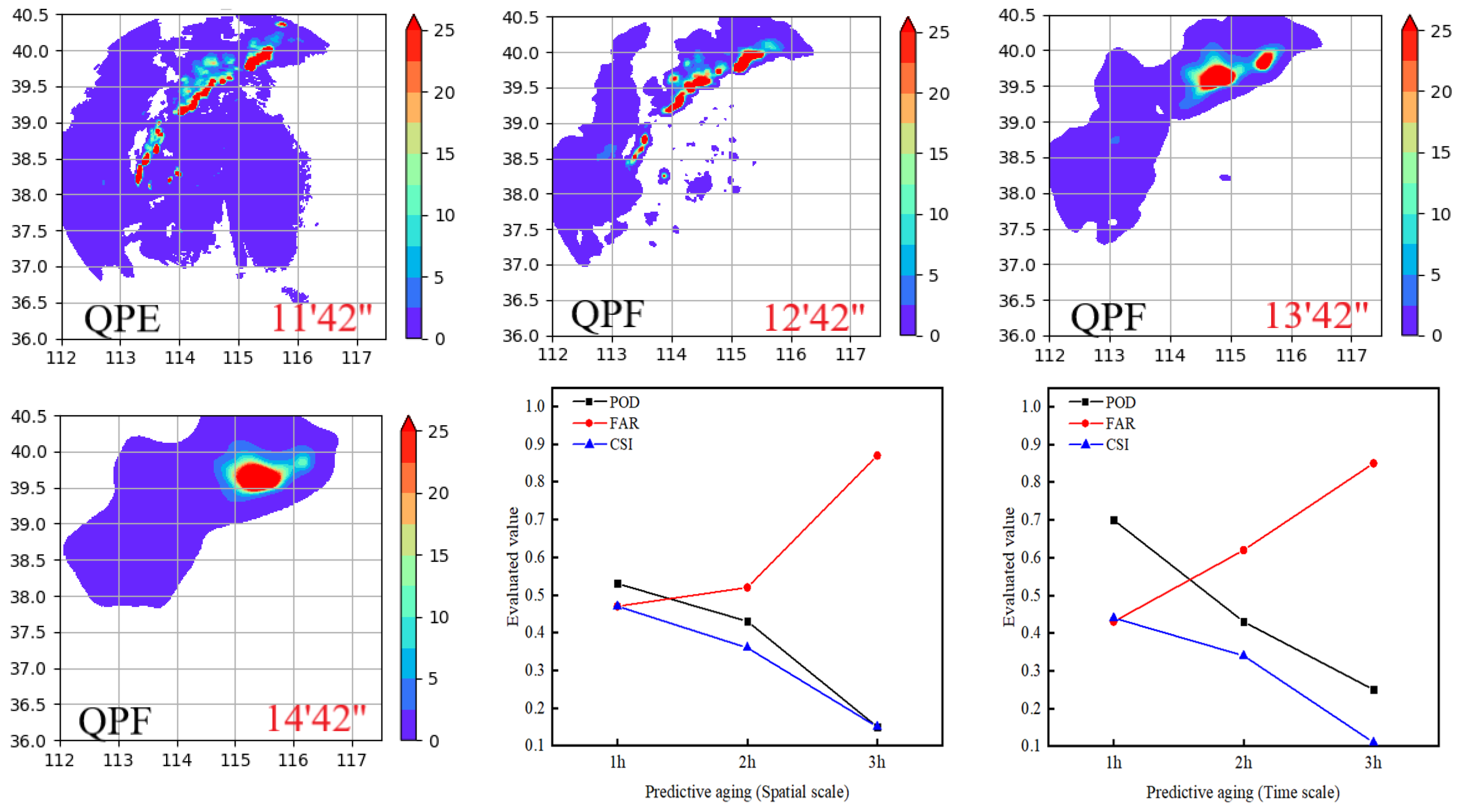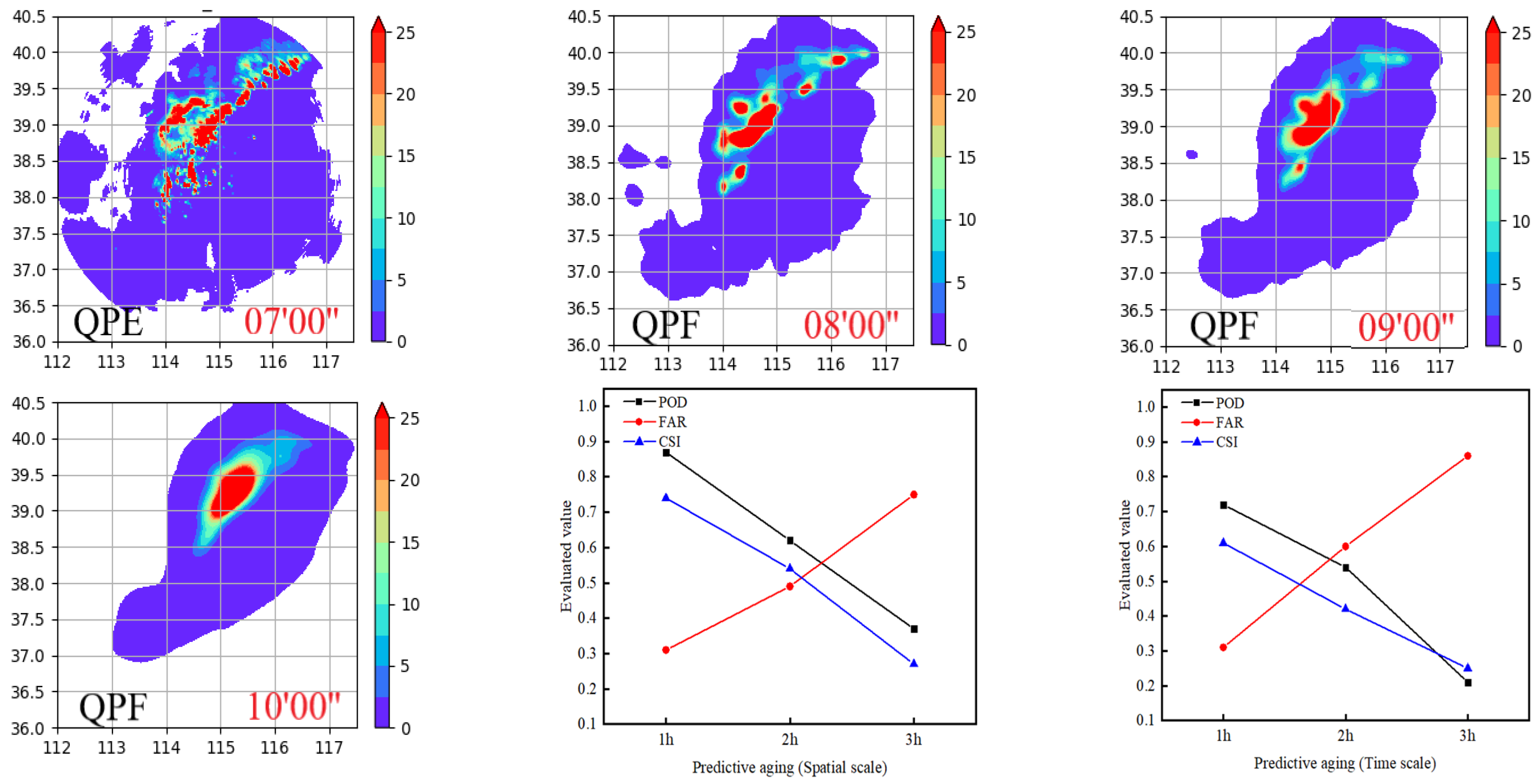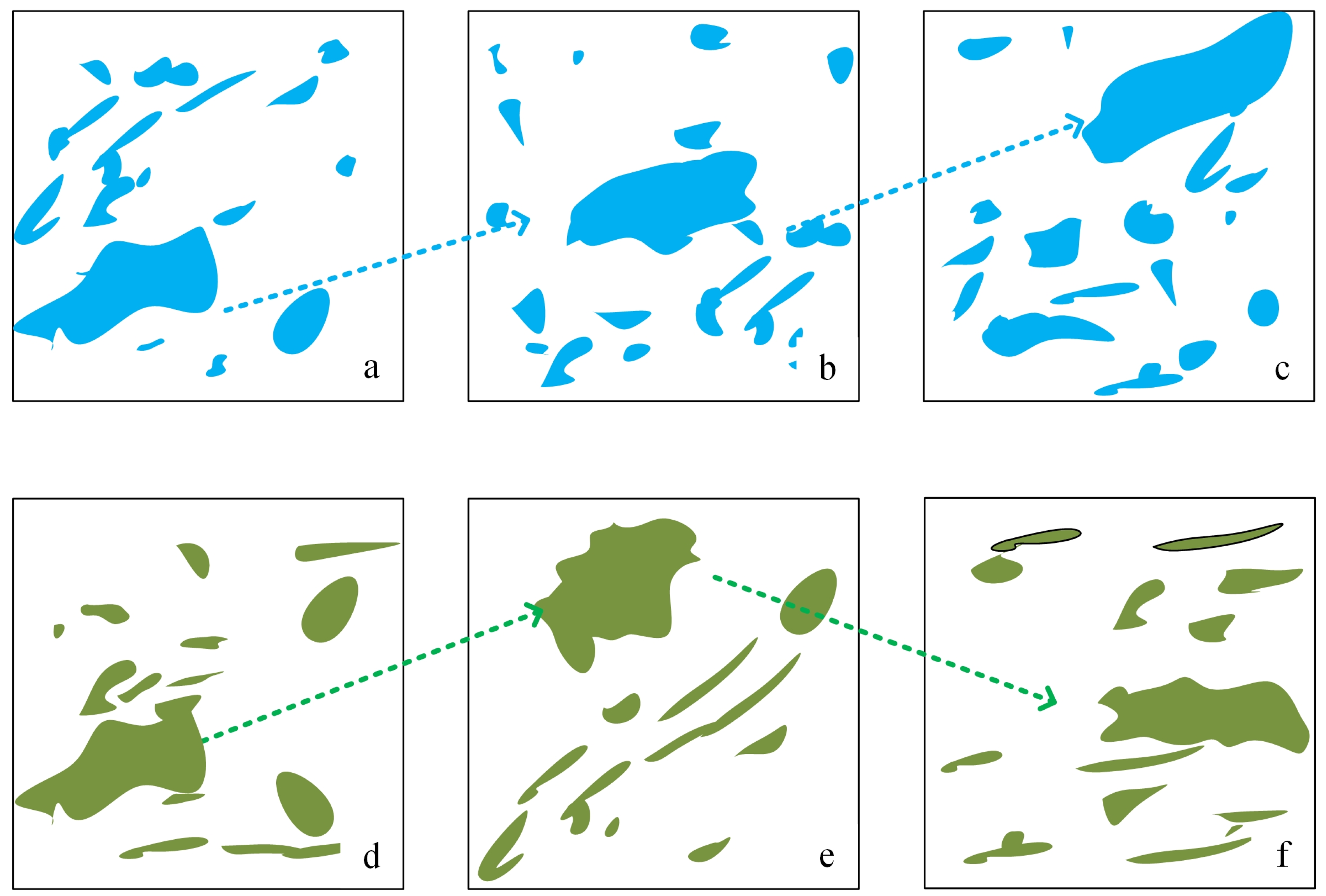Application of Variational Optical Flow Forecasting Technique Based on Precipitation Spectral Decomposition to Three Case Studies of Heavy Precipitation Events during Rainy Season in Hebei Province
Abstract
1. Introduction
2. Data and Study Area
3. Principles and Methods
3.1. Estimation of Advection Field
3.2. Precipitation Spectrum Decomposition Algorithm
3.3. AR2 Autoregressive Extrapolation Forecasting
3.4. Evaluation Methods
4. Forecast Results
4.1. Spatial-Scale Evaluation
4.2. Temporal-Scale Evaluation
5. Discussion
6. Conclusions
- (1)
- The variational optical flow extrapolation forecast based on precipitation spectral decomposition typically has a forecast lead time of no more than 3 h. The deviation becomes noticeable after approximately 2 h, and as the forecast lead time extends, the forecasting ability gradually decreases. For forecasts with a lead time of 3 h, significant differences occur among various indicators, and clear comparability is lacking.
- (2)
- The forecast performance of stratiform cloud weather systems is superior to that of severe convective weather systems, as demonstrated by the following: On the spatial scale, the CSI for precipitation in event I begins to decrease below 0.3 after 1.6 h and continues to decline, whereas the CSI for precipitation in event II starts to fall below 0.3 after 2.8 h. Compared with the optical flow method, the effective prediction time is extended by 0.4 h. On the temporal scale, the CSI for precipitation in event I begins to decrease below 0.3 after 2.2 h and continues to decline, whereas the CSI for precipitation in event II starts to fall below 0.3 after 2.7 h, and for event II, it starts to fall below 0.3 after 2.4 h.
- (3)
- The effective forecast lead time of the variational optical flow prediction technique based on precipitation spectrum decomposition is 1.6 h under severe convective weather conditions, and 2.2 h under stratiform cloud weather conditions. Overall, the forecast effect of this method is good in the three rainfalls, the highest CSI is up to 0.74, the highest POD is up to 0.87, and the forecast accuracy and success rate is high, but there are still some deviations. The research will continue in the later period and strive to find a better forecasting method.
Author Contributions
Funding
Data Availability Statement
Conflicts of Interest
References
- Browning, K.A.; Collier, C.G. Nowcasting of precipitation systems. Rev. Geophys. 1989, 27, 345–370. [Google Scholar] [CrossRef]
- Scofield, R.A.; Kuligowski, R.J. Status and outlook of operational satellite precipitation algorithms for extreme-precipitation events. Weather Forecast. 2003, 18, 1037–1051. [Google Scholar] [CrossRef]
- Austin, G.L.; Bellon, A. The use of digital weather radar records for short-term precipitation forecasting. Q. J. R. Meteorol. Soc. 1974, 100, 658–664. [Google Scholar] [CrossRef]
- Johnson, J.T.; MacKeen, P.L.; Witt, A.; De Wayne Mitchell, E.; Stumpf, G.J.; Eilts, M.D.; Thomas, K.W. The storm cell identification and tracking algorithm: An enhanced WSR-88D algorithm. Weather Forecast. 1998, 13, 263–276. [Google Scholar] [CrossRef]
- Dixon, M.; Wiener, G. TITAN: Thunderstorm identification, tracking, analysis, and nowcasting—A radar-based methodology. J. Atmos. Ocean. Technol. 1993, 10, 785–797. [Google Scholar] [CrossRef]
- Gibson, J.J. The ecological approach to the visual perception of pictures. Leonardo 1978, 11, 227–235. [Google Scholar] [CrossRef]
- Rinehart, R.E.; Garvey, E.T. Three-dimensional storm motion detection by conventional weather radar. Nature 1978, 273, 287–289. [Google Scholar] [CrossRef]
- Kessler, E. Computer program for calculating average lengths of weather radar echoes and pattern bandedness. J. Atmos. Sci. 1966, 23, 569–574. [Google Scholar] [CrossRef]
- Barclay, P.A.; Wilk, K.E. Severe Thunderstorm Radar Echo Motion and Related Weather Events Hazardous to Aviation Operations (Severe Thunderstorm Radar Tracking and Related Weather Events Hazardous to Aviation Operations); ESSA: Halifax, NS, Canada, 1970. [Google Scholar]
- Hu, J.; Rosenfeld, D.; Zrnic, D.; Williams, E.; Zhang, P.; Snyder, J.C.; Ryzhkov, A.; Hashimshoni, E.; Zhang, R.; Weitz, R. Tracking and characterization of convective cells through their maturation into stratiform storm elements using polarimetric radar and lightning detection. Atmos. Res. 2019, 226, 192–207. [Google Scholar] [CrossRef]
- Han, L.; Fu, S.; Zhao, L.; Zheng, Y.; Wang, H.; Lin, Y. 3D convective storm identification, tracking, and forecasting—An enhanced TITAN algorithm. J. Atmos. Ocean. Technol. 2009, 26, 719–732. [Google Scholar] [CrossRef]
- Blackman, T.M. Observations and Interpretations of Differential Phase Shift in Precipitation Using S-and Ka-Band Radars; The University of Manchester: Manchester, UK, 1996. [Google Scholar]
- Tuttle, J.D.; Foote, G.B. Determination of the Boundary Layer Airflow from a Single Doppler Radar. J. Atmos. Ocean. Technol. 1990, 7, 218–232. [Google Scholar] [CrossRef]
- Reich, S. An explicit and conservative remapping strategy for semi-Lagrangian advection. Atmos. Sci. Lett. 2010, 8, 58–63. [Google Scholar] [CrossRef]
- Wu, J.K.; Chen, M.X. Advance in Nowcasting Techniques Based on Radar Echo Area Tracking Algorithm. Meteorol. Sci. Technol. 2018, 46, 57–67. (In Chinese) [Google Scholar]
- Kalnay, E. Numerical Weather Forecasting and Predictability; Cambridge University Press: Cambridge, UK, 2001. [Google Scholar]
- Laroche, S.; Zawadzki, I. Retrievals of horizontal winds from single-Doppler clear-air data by methods of cross correlation and variational analysis. J. Atmos. Ocean. Technol. 1995, 12, 721–738. [Google Scholar] [CrossRef]
- Germann, U.; Zawadzki, I. Scale-dependence of the predictability of precipitation from continental radar images. Part I: De-scription of the methodology. Mon. Weather Rev. 2002, 130, 2859–2873. [Google Scholar] [CrossRef]
- Mandapaka, P.V.; Germann, U.; Panziera, L.; Hering, A. Can Lagrangian extrapolation of radar fields be used for precipitation now-casting over complex Alpine orography? Weather Forecast. 2012, 27, 28–49. [Google Scholar] [CrossRef]
- Lee, H.C.; Lee, Y.H.; Ha, J.C.; Chang, D.E.; Bellon, A.; Zawadzki, I.; Lee, G. McGill Algorithm for Precipitation Nowcasting by Lagrangian Extrapolation (MAPLE) ap-plied to the South Korean radar network. Part II: Real-time verification for the summer season. Asia-Pac. J. Atmos. Sci. 2010, 46, 383–391. [Google Scholar] [CrossRef]
- Seed, A.W. A dynamic and spatial scaling approach to advection forecasting. J. Appl. Meteorol. Climatol. 2003, 42, 381–388. [Google Scholar] [CrossRef]
- Stralrowski, C.M.; Wu, S.M.; DeVor, R.E. Charts for the interpretation and estimation of the second order autoregressive model. Technometrics 1970, 12, 669–685. [Google Scholar] [CrossRef]
- Imhoff, R.O.; Brauer, C.C.; Overeem, A.; Weerts, A.H.; Uijlenhoet, R. Spatial and temporal evaluation of radar rainfall nowcasting techniques on 1533 events. Water Resour. Res. 2020, 56, e2019WR026723. [Google Scholar] [CrossRef]
- Staniforth, A.; Côté, J. Semi-Lagrangian integration schemes for atmospheric models—A review. Mon. Weather Rev. 1991, 119, 2206–2223. [Google Scholar] [CrossRef]
- Horn, B.K.P.; Schunck, B.G. Determining optical flow. Artif. Intell. 1981, 17, 185–203. [Google Scholar] [CrossRef]
- Chang, F.; Wong, A.C.M. Improved likelihood-based inference for the stationary AR (2) model. J. Stat. Plan. Inference 2010, 140, 2099–2110. [Google Scholar] [CrossRef]
- Tian, J.; Liu, J.; Yan, D.; Li, C.; Yu, F. Numerical rainfall simulation with different spatial and temporal evenness by using a WRF mul-tiphysics ensemble. Nat. Hazards Earth Syst. Sci. 2017, 17, 563–579. [Google Scholar] [CrossRef]
- Bowler, N.E.H.; Pierce, C.E.; Seed, A. Development of a precipitation nowcasting algorithm based upon optical flow tech-niques. J. Hydrol. 2004, 288, 74–91. [Google Scholar] [CrossRef]
- Kateri, M. Contingency table analysis. In Methods and Implementation Using R; Springer: Berlin, Germany, 2014. [Google Scholar]
- Su, A.; Li, H.; Cui, L.; Chen, Y. A convection nowcasting method based on machine learning. Adv. Meteorol. 2020, 2020, 5124274. [Google Scholar] [CrossRef]
- Jing, J.; Li, Q.; Peng, X. MLC-LSTM: Exploiting the spatiotemporal correlation between multi-level weather radar echoes for echo sequence extrapolation. Sensors 2019, 19, 3988. [Google Scholar] [CrossRef]
- Miyazaki, Y.; Park, K.C. A formulation of conserving impact system based on localized Lagrange multipliers. Int. J. Numer. Methods Eng. 2006, 68, 98–124. [Google Scholar] [CrossRef]
- Zhu, J.; Dai, J. A rain-type adaptive optical flow method and its application in tropical cyclone rainfall nowcasting. Front. Earth Sci. 2022, 16, 248–264. [Google Scholar] [CrossRef]
- Woo, W.; Wong, W. Operational application of optical flow techniques to radar-based rainfall nowcasting. Atmosphere 2017, 8, 48. [Google Scholar] [CrossRef]
- Pinto, J.; Cai, H.; Lee, G.; Wilson, J.W.; Steiner, M.; Bullock, R.; Albo, D.; Weygandt, S.S.; Phillips, C.L. Beyond Nowcasting of Thunderstorms: An Assessment of Various Blending Techniques for In-creased Forecasting Skill at 2–6 h Lead Times. In Proceedings of the 13th Conference on Aviation, Range and Aerospace Meteorology, New Orleans, LA, USA, 20–24 January 2008; pp. 21–24. [Google Scholar]
- National Research Council. Basic Research Opportunities in Earth Science; National Research Council: Ottawa, ON, Canada, 2001. [Google Scholar]








| Rainfall Events | Rainfall Time | Weather System |
|---|---|---|
| Event I | 21 July 2012 from 9:00 to 21:00 | Convective Precipitation System |
| Event Ⅱ | 20 July 2016 from 0:00 to 18:00 | Stratiform Cloud Precipitation System |
| Event Ⅲ | 18 July 2021 from 0:00 to 11:00 | Stratiform Cloud Precipitation System |
| Forecast Value | Observed Value | Total | |
|---|---|---|---|
| >TR | <TR | ||
| >TR | NA | NB | NA + NB |
| <TR | NC | ND | NC + ND |
| Total | NA + NC | NB + ND | |
| Event | Forecasting Lead Time | POD | FAR | CSI | RMSE | CSI/RMSE |
|---|---|---|---|---|---|---|
| I | 1 h | 0.53 | 0.47 | 0.47 | 1.31 | 0.36 |
| 2 h | 0.43 | 0.52 | 0.36 | 1.92 | 0.19 | |
| 3 h | 0.15 | 0.87 | 0.15 | 3.57 | 0.04 | |
| II | 1 h | 0.87 | 0.31 | 0.74 | 1.13 | 0.65 |
| 2 h | 0.62 | 0.49 | 0.54 | 1.89 | 0.29 | |
| 3 h | 0.37 | 0.75 | 0.27 | 2.76 | 0.10 | |
| III | 1 h | 0.67 | 0.33 | 0.61 | 1.54 | 0.40 |
| 2 h | 0.49 | 0.50 | 0.43 | 2.18 | 0.20 | |
| 3 h | 0.32 | 0.78 | 0.24 | 3.10 | 0.08 |
| Event | Forecasting Lead Time | POD | FAR | CSI | RMSE | CSI/RMSE |
|---|---|---|---|---|---|---|
| I | 1 h | 0.7 | 0.43 | 0.44 | 1.17 | 0.38 |
| 2 h | 0.43 | 0.62 | 0.34 | 1.89 | 0.18 | |
| 3 h | 0.25 | 0.85 | 0.11 | 3.7 | 0.03 | |
| II | 1 h | 0.72 | 0.31 | 0.61 | 1.03 | 0.59 |
| 2 h | 0.54 | 0.60 | 0.42 | 1.76 | 0.14 | |
| 3 h | 0.21 | 0.86 | 0.25 | 2.91 | 0.01 | |
| III | 1 h | 0.72 | 0.41 | 0.54 | 1.59 | 0.34 |
| 2 h | 0.51 | 0.61 | 0.35 | 1.95 | 0.15 | |
| 3 h | 0.26 | 0.83 | 0.21 | 3.12 | 0.07 |
Disclaimer/Publisher’s Note: The statements, opinions and data contained in all publications are solely those of the individual author(s) and contributor(s) and not of MDPI and/or the editor(s). MDPI and/or the editor(s) disclaim responsibility for any injury to people or property resulting from any ideas, methods, instructions or products referred to in the content. |
© 2023 by the authors. Licensee MDPI, Basel, Switzerland. This article is an open access article distributed under the terms and conditions of the Creative Commons Attribution (CC BY) license (https://creativecommons.org/licenses/by/4.0/).
Share and Cite
Tian, J.; Qiu, Q.; Zhao, X.; Mu, W.; Cui, X.; Hu, C.; Kang, Y.; Tu, Y. Application of Variational Optical Flow Forecasting Technique Based on Precipitation Spectral Decomposition to Three Case Studies of Heavy Precipitation Events during Rainy Season in Hebei Province. Water 2023, 15, 2204. https://doi.org/10.3390/w15122204
Tian J, Qiu Q, Zhao X, Mu W, Cui X, Hu C, Kang Y, Tu Y. Application of Variational Optical Flow Forecasting Technique Based on Precipitation Spectral Decomposition to Three Case Studies of Heavy Precipitation Events during Rainy Season in Hebei Province. Water. 2023; 15(12):2204. https://doi.org/10.3390/w15122204
Chicago/Turabian StyleTian, Jiyang, Qingtai Qiu, Xiaoqi Zhao, Wenbin Mu, Xidong Cui, Chunqi Hu, Yajing Kang, and Yong Tu. 2023. "Application of Variational Optical Flow Forecasting Technique Based on Precipitation Spectral Decomposition to Three Case Studies of Heavy Precipitation Events during Rainy Season in Hebei Province" Water 15, no. 12: 2204. https://doi.org/10.3390/w15122204
APA StyleTian, J., Qiu, Q., Zhao, X., Mu, W., Cui, X., Hu, C., Kang, Y., & Tu, Y. (2023). Application of Variational Optical Flow Forecasting Technique Based on Precipitation Spectral Decomposition to Three Case Studies of Heavy Precipitation Events during Rainy Season in Hebei Province. Water, 15(12), 2204. https://doi.org/10.3390/w15122204





